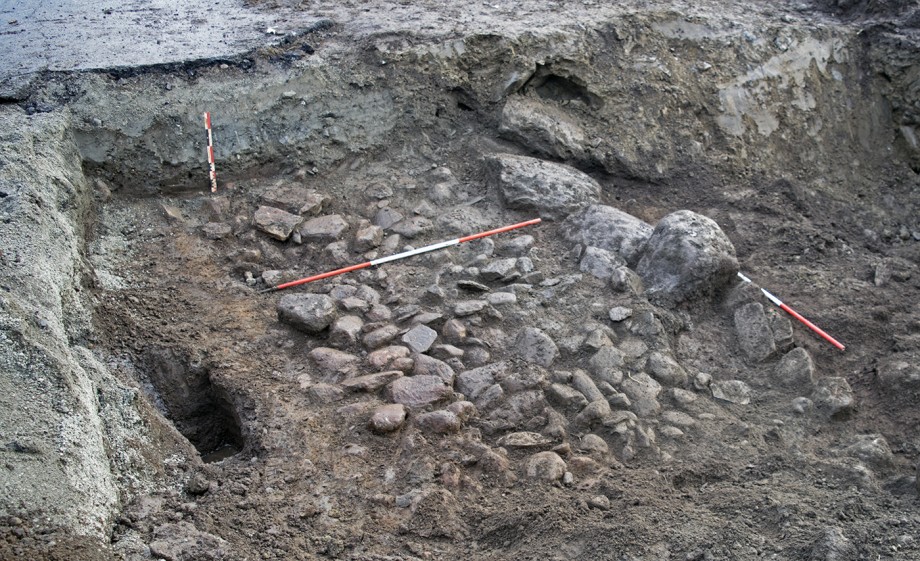A paved road from the Viking Age was found during an archaeological excavation at Madla in Stavanger. The road dates all the way back to 850 AD.

First published 11.04.2017
“Finding such ancient, yet well-preserved traces of roads used by people and animals is quite a rarity”, says Even Bjørdal, archaeologist at the Museum of Archaeology at the University of Stavanger. Bjørdal was project leader for the Madla excavation.
“The road is important because it will help improve our understanding of the use of the farms and landscape here beside the Hafrsfjord in the early Iron Age and Middle Ages”, he says.
The road was probably first constructed in connection with a reorganisation of properties and farms in the region, during the Viking Age. During the period when the road was constructed, the settlement appears to have been moved from the farmstead dating back to the late Iron Age, to the historic farmyard just beside it.
“We do not yet know how far the old road stretches from the excavation site – what we do know for certain is that it goes off in both directions”, explains the archaeologist.
Graves from the early Iron Age
The purpose of the excavation, which took place during the summer and autumn of 2015, was to investigate the development of settlements in an area where protected cultural monuments had previously been recorded, beside the Sundeveien road at Madla in Stavanger.
Documented traces of buildings and farming from the Bronze Age and Iron Age had also been found. The archaeologists also found traces of several buildings from Roman times and the Iron Age, and an area containing dozens of graves without preserved grave goods.
The assumption is that the graves date back to the early Iron Age.
During their time at Sunde, the archaeologists were commissioned by the Directorate for Cultural Heritage to perform further archaeological investigations in the area where the modern road runs.
Traces on old maps
“Today’s asphalt road twists and turns through the landscape, past houses and farms. But old maps show that there was already a road here in the early 19th century”, relates Bjørdal.
This road had never previously been investigated, and the Directorate for Cultural Heritage wanted to know more about the age of the Sundevegen road before the area had been developed. The excavation of the road became a project of its own, funded by the Directorate for Cultural Heritage.
Could this road have been constructed during the Middle Ages – or maybe even earlier?
“We simply dug a hole in the road with an excavator, approximately five times five metres in size. Once we cleared away the sand and gravel of the present day, we came upon a paved stone surface”, explains Bjørdal.
“We were delighted and surprised to find clear remains of a paved stone surface”.
800 year old road
The road was around two metres wide and ran in the same direction as the modern road. When the archaeologists created a so-called cross-section through the stone paving, which meant digging a deeper section through around half the road in order to see what was there, they discovered that the road had been in use for more than one period.
There were several layers of stone paving. When they dated soil samples from the various layers, it transpired that the road had been in use for almost 800 years.
Many of the bigger stones along the southern edge of the road probably came from a fence which was known to be in the area in the 20th century, but the possibility that some of these kerbstones could have been part of the original stone paving cannot be ruled out.
Three 14C analyses of samples from the various layers in this road have been carried out. This is a method of dating organic material. The dating indicates that the upper layer was in use for the centuries before and after the Reformation, between 1441–1635 AD, while the lower, older phases date back to the Viking Age, i.e. 850–1020 AD.
Text: Ragnhild Nordahl Næss
This article has also been published on forskning.no
